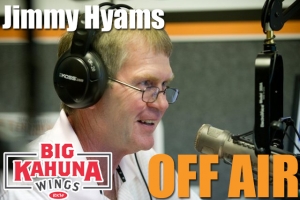
By Jimmy Hyams
College football coaches who like to throw temper tantrums might get thrown out of games before the contest ends.
The NCAA has adopted a rule saying coaches can’t leave the sideline to argue with officials, unless given permission by the official.
It seems unlikely a ref would invite a coach onto the field to get a butt chewing.
Thus, any offending coach will be assessed a 15-yard unsportsmanlike penalty. Getting two in the same game will result in ejection.
“It’s designed to curb coaches behavior,’’ said SEC coordinator of officials Steve Shaw, who conducted a seminar for media at the annual SEC Spring Meetings last week.
Coaches are allowed to go onto the field during a timeout or to assess an injury to a player. A coach might also step onto the field to call plays.
But not rip into a ref.
What is the reaction of the coaches?
“I don’t think anybody loves it,’’ Shaw said, “but they don’t want to be the first one ejected.’’
Among the leading coaching candidates to get flagged: Alabama’s Nick Saban, South Carolina’s Will Muschamp and Tennessee’s Butch Jones.
How quickly coaches conform will make for an interesting study this season.
Another rule change regards the uniform. Players are required to wear knee pads and pants that cover the knees. A player that cuts his pants a few inches above the knee will be asked to leave the field for one play or until his uniform conforms. A player may be allowed to stay in the game and not miss a play if his team calls a timeout.
While this rule isn’t supposed to go into affect until 2018, if a player is in clear violation of the rule – for example, cutting the pants to 3-6 inches above the knee – the player will be sent to the sideline.
Shaw said this can be policed by officials before a game — letting the players and the coaches know what complies to the rule.
“The medical community says we need knee pads for football,’’ Shaw said.
Shaw said the targeting rule has not changed but player behavior has. He said it’s apparent more players are avoiding helmet-to-helmet contact and not leading with the crown of their helmet.
Shaw said five targeting fouls were called from the SEC collaborative replay headquarters in Birmingham; last year was the first time replay officials could call targeting. He said the SEC had two more targeting calls than the year before.
Shaw also said forcible contact to the neck or head by a helmet or shoulder hit on a defenseless player is a 15-yard penalty. Many cases of a defenseless player occur on returns – punts, kickoffs, interceptions, fumbles — when the would-be tackler doesn’t see the blocker coming.
The NCAA has enacted many rules aimed at player safety in the past half decade.
Because of the emphasis on safety, Shaw said: “The game is safer than it’s ever been in the history of football.’’
In other topics:
*Players can no longer leap or hurdle over the snapper to block a field goal or extra point attempt. In the past, a player could leap or hurdle as long as he didn’t touch another player. However, Shaw said a player standing within a yard of the line of scrimmage is allowed to jump over the snapper to block a kick provided he doesn’t make contact with another player. Finding such an athletic player would be difficult.
*The horse-collar rule has been expanded to say if a tackler grabs a ballcarrier by the back of the shoulder pads OR near the name plate area and immediately pulls the runner down, that is a foul.
*Last year, the length of an SEC game was 3 hours, 26 minutes, ranking near the middle of all conferences. Two games lasted less than three hours, four went over four hours (two were overtime games). Shaw said he doesn’t have a time limit in mind since so many college offenses vary from a triple-option to a pass-every-down spread, but he thinks officials can cut about 5-6 minutes out of a game. How? By “keeping the game moving’’ and slicing a couple minutes out of halftime. While halftime lasts 20 minutes, officials used to start the halftime clock when both teams had exited the field. Now that clock will start when the last play of the first half ends.
*Shaw said collaborative replay is used in some form by all Power 5 conferences. He said the average length of replay in the SEC was 1:26. It was about 1:45 the first two weeks of the season as officials adjusted to collaborative replay. Shaw said collaborative replay resulted in 8 percent improvement on getting calls correct.
Regarding replay, Shaw said: “It gives the coach a second level of confidence; it gives me a second level of confidence that we will get it right.’’
Big Kahuna Wings: The wings that changed it all















